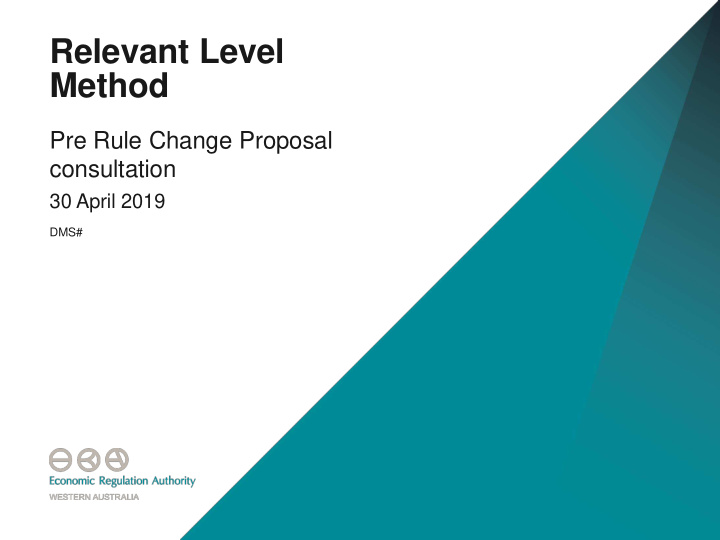



Relevant Level Method Pre Rule Change Proposal consultation 30 April 2019 DMS#
Agenda 01 04 Recommendation for change Next steps 02 Implementation options: Market Rule vs Market Procedure 03 Network constraints
RLM recommendation recap • Approach is unchanged – Effective Load Carrying Capability • Method of calculation to change: • from the current, formula-based approach: – Downward adjustment to intermittent generators’ average output during a sample of periods in the last five years. • to a numerical model – Historical time series data on intermittent and scheduled generators’ output and demand to forecast the capacity value of the intermittent generation fleet two years ahead. 3
RLM recommendation benefits • Small incremental, computational burden and administration costs. • Uses basic statistical and probability-based concepts. • Provides a more reliable forecast than the current method. • Independent of the generation mix so can continue to calculate capacity values for intermittent generators as the WEM evolves. 4
Consultation with the MAC • Rule 2.5.1B requires the ERA to consult with the MAC before commencing a rule change proposal on: – The matters to be addressed by the rule change proposal. – Options to resolve the matters. – The ERA’s estimated costs of developing the rule change. – Whether an when the ERA should develop the rule change proposal – Whether and how the MAC should be consulted during the rule change development. 5
Market Rule and/or Market Procedure Information to be included: • specification of the numerical model • details of the calculation • required input data • the party responsible for the development of the model • a quality assurance mechanism. Considerations are – Transparency, Flexibility and Stability. Options are: • detailed prescription in the Market Rules • development of a detailed Market Procedure • development of guidelines in the Market Rules. 6
Detailed Market Rule or Market Procedure Transparency and Stability: Could clearly explain the method, model type (system adequacy assessment), input data, allocation method and QA. Would eliminate frequent changes to the method and therefore could enhance market participants’ and new entrants’ confidence in the calculation method. Flexibility A detailed rule or procedure would limit flexibility in enhancing the method. Particularly important when the model is first implemented, when the need for improvements to the model may become evident. Changes in other market rules, such as the planning criterion, may also necessitate changes in the calculation. 7
Market Rule Guideline Flexibility: Would only contain the purpose of the method and broad guidelines, e.g. only specify that the calculation of capacity value is based on ELCC and the Planning Criterion. Flexibility to develop a system adequacy assessment model and determine the ELCC of intermittent generators. Transparency and Stability Details of the calculation would be opaque. Frequent changes to the calculation can also increase the variability of results. Market participants and new entrants would have limited information to assess the number of capacity credits they receive and thus form a reasonable expectation of associated cash flows in the future. This can increase the cost of capital for funding investments in supply capacities in the SWIS. 8
Recommendation I • Guidelines to be included in the Market Rules as to how the model should be developed and what the model should deliver. • Detailed specification of the model in a market procedure. • Transitional arrangements. • ERA reviews the RLM and develops the Market Procedure • Receiving support from AEMO • Possible conflict of interest: ERA reviews the method and develops the market procedure. – AEMO could own the market procedure: however, will be superseded by the ERA’s review – Would not resolve the ERA’s possible conflict of interest (AEMO develops the market procedure consistent with the ERA’s review) 9
Recommendation II Benefits of this approach: • Transparency - existing and potential intermittent generators can make informed investment decisions. • Flexibility – enhancements to the model specification to be incorporated more flexibly and less costly than initiating a new rule change proposal. • Stability: • Transitional arrangements can ‘smooth’ any financial implications of moving from one method to another. • Sweeping up any related but unused (and inconsistent) market rules in the RLM rule change. – Early certification of reserve capacity (Rule 4.28C) – Conditional certification of reserve capacity (Rule 4.9.5) 10
Effect of network constraints • The RLM recommendations were developed on the understanding that the resulting capacity values are an input into the determination of capacity credit allocations under constrained network access. • This makes credit allocation a two-step process – reduces transparency. • Not the approach taken in other jurisdictions. • RCP will need to take the RLM rule change proposal into account with other associated rule changes proposed as part of WEM reforms. 11
Next steps • Can discuss further at ERA Energy Market’s workshop on 16 May. • Market Regs team will develop the Rule Change Proposal. • How the MAC should be consulted during the rule change development? 12
Thank you Ask any questions Level 4, 469 Wellington Street, Perth WA 6000 Phone: 08 6557 7900 Email: info@erawa.com.au
Recommend
More recommend